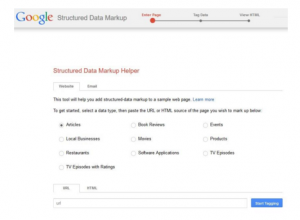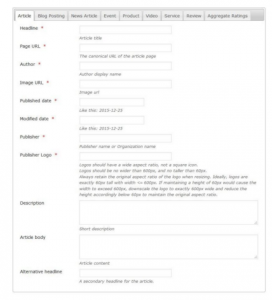What is Structured Data & Schema for Websites & SEO? written by Guest Post read more at Duct Tape Marketing
 For business owners and even for many marketing consultants, search engine optimization can seem like a headache – especially when it comes to any level of technical SEO.
For business owners and even for many marketing consultants, search engine optimization can seem like a headache – especially when it comes to any level of technical SEO.
The good news is that a professional marketing strategy that is powered by a search engine friendly website and consistent content marketing, many small business websites can achieve at least some level of search engine visibility without getting too deep into the SEO weeds.
Yet, in more competitive local niches, and certainly at the national level, there is a more complex world of technical SEO that needs to be addressed in order for your site to have a fighting chance.
Schema is a topic that many in SEO service providers find to be complicated and difficult. In fact, the previous head of Bing Search, Duane Forrester, said at an SMX conference that most people get schema wrong. In fact, I often hear many experienced web designers and SEO specialists that either don’t use schema or have difficulty implementing this newer type of SEO website code – and this is understandable once you start browsing through the thousands of pages at Schema.org.
Let’s Clear Up Come Confusion
In the world of SEO website code, you will hear terms like Structured Data, Schema and Rich Snippets. Most people have no idea what these are or they (incorrectly) use them interchangeably:
- Structured Data: Structured data is a way for digital content publishers to highlight or “tag” content on their web pages to help search engines know exactly what certain content relates to. In other words, structured data gives search engines another dimension of context for web page content.
- Schema: Schema is a shared markup vocabulary listed at Schema.org that is recognized by search engines to help with structured data efforts. In other words, Schema represents the building blocks of Structured Data.
- Rich Snippets: If your Structured Data coding is implemented correctly, the search engines will use the Structured Data on your website to display key information right into the search results page. This bonus search engine “bling” is often referred to as rich snippets.
What does Structured Data do?
In a nutshell, structured data is a detailed set of website code that is “under the hood” of your website. If you know some SEO basics, you are probably familiar with the meta page title and meta description on your web pages – these are usually the blue linked text and black description text that appear in on the search results page. Just like your page title and meta description, Schema is extra code that gives context to the search engines in a standard format that they understand. With structured data, you can clearly define to the search engines the content on your web pages.
When Google accesses this code on your site and deems it valuable to the searcher, they might add extra information right into the results via a rich snippet.
A common (and highly coveted) example of a rich snippet is when you see a star rating review or aggregate rating review show up right on the Google search results page. A review on your website is a great example of content that will not be shown in search results unless you add the right schema code into your website in the right place.

Here are some examples where you see structured data on the SERPs:
- Knowledge Graph: the upper right box that shows up in search results for company name searches or brand searches
- Aggregate Star Review Ratings in search results
- Product ratings in Search results
- Event details that appear in search results
- Search box for your site that shows up in search results
- Video thumbnails’ that show up in search results
Schema Helps SEO, Big Time
There is no doubt that schema has a big impact on your rankings. Although right now, this is primarily an indirect effect. How so? Rich snippets (schema-triggered data in SERPs) have a HUGE impact on organic click through rate (CTR), and it’s well known that CTR is an organic ranking factor. Think about it. When you see event data or review data within a search result, aren’t you more compelled to click those results?
But wait, there’s more.
Like the mobile friendly ranking update that was launched in 2014, Google is now starting to give some pretty strong hint that schema will become a direct ranking factor.
The Three Schema Formats
- MicroData, as defined by Wikipedia, is a WHATWG HTML specification used to nest metadata within existing content on web pages. Search engines, web crawlers, and browsers can extract and process Microdata from a web page and use it to provide a richer browsing experience for users.
- RFDa or Resource Description Framework in Attributes is another format that adds a set of attribute-level extensions to HTML, XHTML and various XML-based document types for embedding rich metadata within web pages.
- JSON-LD is the latest and greatest Schema format and my personal favorite because of the ease of implementation (and I think it's Google’s favorite too): In Google’s own words: JSON-LD is the newest and simplest markup format: it lets you embed a block of JSON data inside a script tag anywhere in the HTML. Since the data does not have to be interleaved with the user-visible text, it's much easier to express nested data items (say, the Country of a PostalAddress of a MusicVenue of an Event). Also, Google can read JSON-LD data even when it is dynamically injected into the page's contents, such as by Javascript code or embedded "widgets.”
Google Has Made It A Little Easier
Google know schema and website code, in general, is very difficult for most users to implement. Yet, they desperately want you to use schema because it makes their search engine more accurate and enables them to show more useful information in search results.
They have made some tools for you to generate this code. The first is Google’s structured data markup helper. This online wizard will help you generate schema code for your web page. Once generated, you will have to install on your website. This tool is awesome because it takes the guesswork out of what schema to use and guides you how to “tag” the element on your site. You simply paste in the webpage URL that you want to tag and follow the guide.
The downside is that once the code is generated, you have to install it on your site. This is where some of the pain comes in for business owners and even marketers that tend to lose confidence once they have to make changes to a WordPress site (for example) where you get out of the CMS admin environment.

Another tool is the Structured Data Highlighter in Google Search Console (formerly Google Webmaster Tools). This tool enables you to highlight and tag structured data with your GSC account. This is a nice feature, but it does not include all the data tags and the tagging you do in this account does not reside on your website. This tool is not really a replacement for adding structured data to your website, but it does help “teach” Google about data patterns on your website.
One More Tool
As an Internet marketing strategist that handle dozens of SEO campaigns for companies of all sizes, my team was spending too much time trying to add and optimize structured data on our clients’ WordPress websites. There are a ton of structured data plugins for WordPress out there, but many are either difficult to use or only provide markup for something specific, such as ratings. I found no comprehensive, easy-to-use structured data plugins for small business websites or for local search engine optimization.
Further, very few schema plugins support JSON-LD, the latest and greatest in structured data code. This is really important because with JSON-LD you don’t have to mess with shortcode or HTML, which makes it easier for a developer like myself to create a very user-friendly plugin that is also “less invasive” to existing website code.
So recently I released my own free WordPress plugin that enables you to set up structured data on your website, modeled exactly after the way Google guidelines on Structured Data.
Except with my plugin, you never have to mess with any code or with the Google structured data tools, nor log into Google Search Console to tag data through your (or your client’s accounts). Be sure to download my SEO Structured Data WordPress plugin (available February 2016) and give it a try!

 Phil Singleton is a self-described ‘SEO grunt’ obsessed with tweaking websites for search engine optimization and conversions, and creating WordPress SEO & PPC plugins. He owns & operates Kansas City Web Design®, a top Kansas City web design agency, and Kansas City SEO®. Phil is co-author author of the Amazon best-seller The Small Business Owner’s Guide To Local Lead Generation (2015), and author of the Amazon best-selling Kindle eBook How To Hire A Web Designer: And Not Get Burned By Another Agency (2015). Visit his websites at http://kcwebdesigner.com and http://kcseopro.com, or connect with Phil Singleton on LinkedIn.
Phil Singleton is a self-described ‘SEO grunt’ obsessed with tweaking websites for search engine optimization and conversions, and creating WordPress SEO & PPC plugins. He owns & operates Kansas City Web Design®, a top Kansas City web design agency, and Kansas City SEO®. Phil is co-author author of the Amazon best-seller The Small Business Owner’s Guide To Local Lead Generation (2015), and author of the Amazon best-selling Kindle eBook How To Hire A Web Designer: And Not Get Burned By Another Agency (2015). Visit his websites at http://kcwebdesigner.com and http://kcseopro.com, or connect with Phil Singleton on LinkedIn.
No comments:
Post a Comment